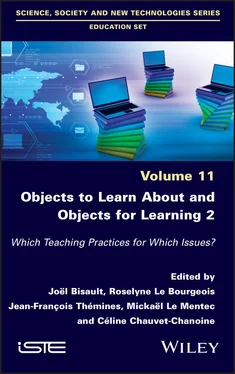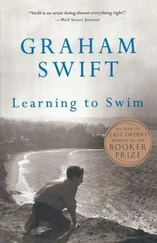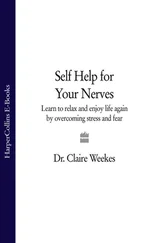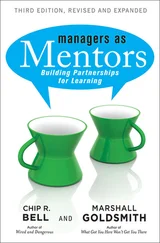Table 1.2. Indefinite places
| Indefinite places |
Frequency |
| Town hall |
5 |
| Home – school |
4 |
| Police |
3 |
| Hospital |
2 |
| Fire station – dentist – museum – veterinarian – supermarket – train station – street – church – mausoleum – beach – mosque – garden – classroom – mountain |
1 |
A second set of responses could be divided into two groups ( Tables 1.3and 1.4) included spatial references that were now identifiable, but still too vague and large to fit the framework proposed in this project. The largest spatial containers, namely the continents, were mentioned and recognized, with the exception of Oceania, typically confounded with Australia, which was mentioned in the country category. The countries were primarily European. We noted countries with large areas (Russia, China, Brazil), most of the countries bordering France, and those with family relationships (the Maghreb). The cities were primarily French, with Paris at the top of the list; Tourcoing was naturally mentioned in the same breath as Lille.
Table 1.3. Cities
| Countries |
Cities |
Frequency |
|
Paris |
7 |
| Lille – Tourcoing – Marseille |
3 |
| Lyon – Strasbourg – Montpellier |
2 |
| Nice – Nantes – Toulouse – Nîmes – Toulouse – Bordeaux |
1 |
| Others |
London – Rome |
1 |
Table 1.4. Spatial containers
| Spatial containers |
|
Continents |
Frequency |
| Asia |
3 |
| Europe – Africa |
2 |
| America – Antarctica |
1 |
| Continents |
Countries |
Frequency |
| Europe |
Italy – Russia |
5 |
| France |
4 |
| Belgium – Spain – Portugal |
3 |
| United Kingdom |
2 |
| Germany – Romania – Switzerland |
1 |
| Oceania |
Australia |
1 |
| Africa |
Algeria |
2 |
| Tunisia – Egypt |
1 |
| Asia |
Russia |
5 |
| China |
2 |
| America |
Brazil |
2 |
| Argentina – Mexico |
1 |
Table 1.5. Locatable points of reference
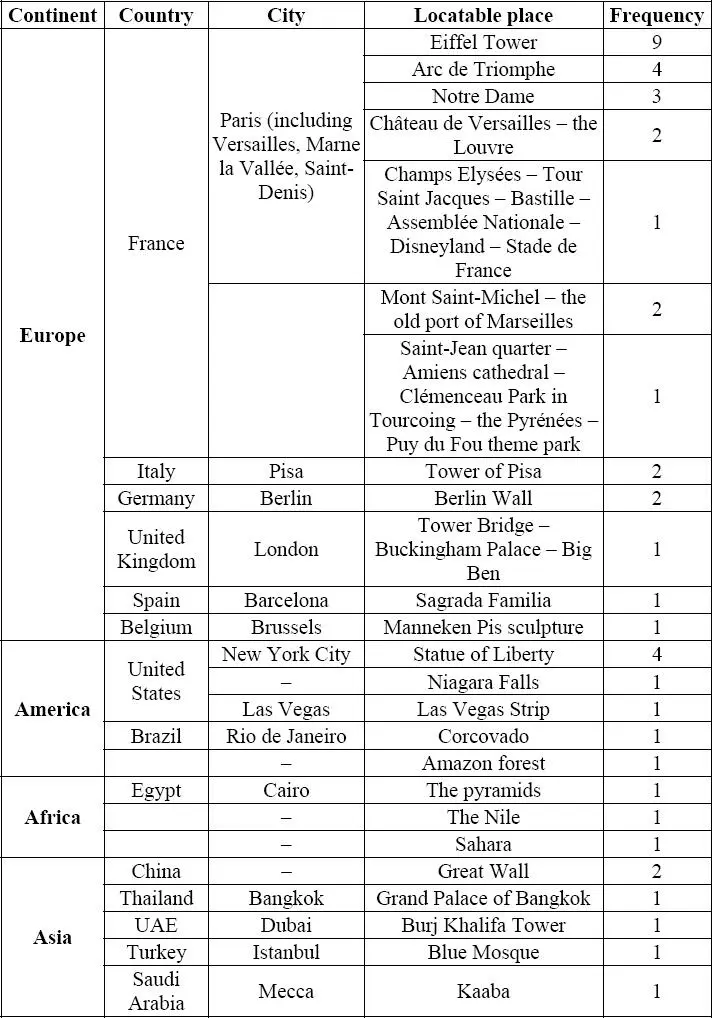
A third group of responses ( Table 1.5) appeared promising for the rest of the project, as it included locatable points of reference with sufficient precision to lead to a system of clues, one of which would be based on the location as a member of a higher level (city, country, continent). Europe was also overrepresented in this list in relation to other continents, as was France in relation to other countries and Paris in relation to other cities. A few places typically visited during summer vacations were included by four pupils (Burj Khalifa tower, the pyramids of Egypt, the old port of Marseilles and Disneyland). Major urban landmarks were included (Statue of Liberty, Tower of Pisa, Corcovado, Sagrada Familia), as were natural sites (the Nile, Niagara Falls, Sahara). What was also notable was the dominance of British (Britain having already been studied at the beginning of CM2) and especially Parisian reference points (the “cultural capital” effect). Since the work was done at home, several pupils admitted to having used the Internet, but they said they did not ask their parents. The points of reference from this list that were used in the final game are listed in yellow; we will come back to discuss this.
1.4.3. Game stabilization and lifespan
Keeping the pupils in suspense throughout the project was not particularly easy. A variety of factors played a part in their assimilation of the process (their own interest toward the subject, their ability to conduct research and to produce a short relevant text, projection in the development of a tool over the long term whose limits were undefined: there was no maximum number of points of reference that could be proposed).
Thus, it was necessary to accept down time in the development of the tool, and the project had to be relaunched on a regular basis in a variety of ways, essentially in order to prompt the pupils to follow through on their initial suggestions and to produce the clue sentences that would lead to the correct answer. Table 1.6shows different elements connected to these constraints. The 24 points of reference are the ones that were kept throughout the year, which were accepted by most of the class because they were considered “finished” by the pupils that had constructed them; in other words, the three clue sentences that made them usable had been written. The pupils’ level of investment was thus quite variable; several of them were content to suggest the names of points of reference without seeking to suggest the elements that would make it possible to define them. As shown in the last column of the table, three main sets can be seen: the September–October period, which was marked by the initial suggestion of “finding important places to know how to locate”; the November–December period, during which the idea was relaunched with a focus on travel enabled by a sabbatical year and an associated budget: “what are the places you would like to visit if you had a sabbatical year and the budget to pay for travel?”; and the January–February period, when the pupils were prompted to work in groups using recommended documents (atlas, maps, dictionaries, other works, etc.) to create new points of reference in class. The last relaunch also had the objective of showing the over-representation of locatable points of reference on the map of the world, while few were kept for the maps of Europe and France, thus initiating an attempt to rebalance from then on. There were no subsequent relaunches, as the end of the year was taken up with assessments.
Table 1.6. The retained points of reference and project relaunches
|
Place |
Type |
Location |
Initiating element by period |
| 1 |
Tower of Pisa |
Monument |
Europe (Italy) |
September/October: the ten key places |
| 2 |
Eiffel Tower |
Monument |
France |
| 3 |
Statue of Liberty |
Monument |
World (America) |
| 4 |
Amazon forest |
Nature |
World (America) |
| 5 |
Dumont d’Urville Station |
Science |
World (Antarctica) |
| 6 |
Easter Island statues |
Monument |
World (America) |
| 7 |
Capoeira |
Culture |
World (America) |
November/December: sabbatical year |
| 8 |
Kangaroo |
Nature |
World (Oceania) |
| 9 |
Kiwi |
Nature |
World (Oceania) |
| 10 |
Cliffs at Etretat |
Nature |
France |
| 11 |
Burj Khalifa Tower |
Monument |
World (Asia) |
| 12 |
Hollywood |
Monument |
World (America) |
| 13 |
Villa Mandessi Bell |
Monument |
World (Africa) |
| 14 |
Emperor penguin |
Nature |
World (Antarctica) |
January/February: group work and in-class creation based on documents |
| 15 |
Statue of Jean Bart (Dunkirk) |
Monument France |
|
| 16 |
Lascaux Caves |
Monument |
France |
| 17 |
Corinth Canal |
Transport |
Europe (Greece) |
| 18 |
Blue Mosque |
Monument |
Europe (Turkey) |
| 19 |
Christ the King |
Monument |
Europe (Portugal) |
| 20 |
Piton de la Fournaise volcano |
Nature |
World (Réunion) |
| 21 |
Tokyo Tower |
Monument |
World (Asia) |
| 22 |
Lindt chocolate |
Gastronomy |
Europe (Switzerland) |
| 23 |
Giraffe |
Nature |
World (Africa) |
| 24 |
Château de Pau |
Monument |
France |
Finally, 14 points of reference that could be located on a map of the world were retained, with five locations on the map of Europe and five more on the map of France. The types of points of reference, if they did not seem important a priori to be able to locate, nevertheless showed that the pupils were very sensitive to the symbolism of monuments (13 out of 24) as well as to nature, particularly through animals, which are beloved by children (7 of the 24). The list retained for the world shows both major locations and gaps: America is over-represented through the United States and Brazil; the countries of Europe are essentially those that border France. Unlike a historical timeline (even if these can accommodate zooming in on a year, for example), the form of the tool was also constraining since it concerned spatial representation. The small card for the point of reference to be placed on the wall map could completely cover some small countries, hence their absence (even if it was still possible to imagine placing the small map of the point of reference on one of the edges of the wall map and connecting it with a line to its real location). Variations in scale also came into play in the image of Turkey, which is typically considered to be part of the Asian continent, but which was easier to place on the map of Europe because the country was larger in that representation. It should also be noted that five points of reference – numbers 11, 13, 15, 19 and 24 – were the result of personal travel experiences (vacations or family origins).
Читать дальше
